Economics for Managers: Great Recession Analysis
VerifiedAdded on 2019/10/31
|13
|2985
|178
Essay
AI Summary
This essay provides a detailed analysis of the Great Recession of 2007-2009 in the United States, focusing on the primary cause, which was the housing bubble. The essay discusses the factors that led to the bubble, its bursting, and the subsequent economic downturn, including the decline in GDP, increased unemployment, and the overall impact on the US economy. It also touches upon the long-term effects and the measures taken to recover from the crisis. The essay uses data and graphs to support its analysis and provides a comprehensive overview of the economic event.
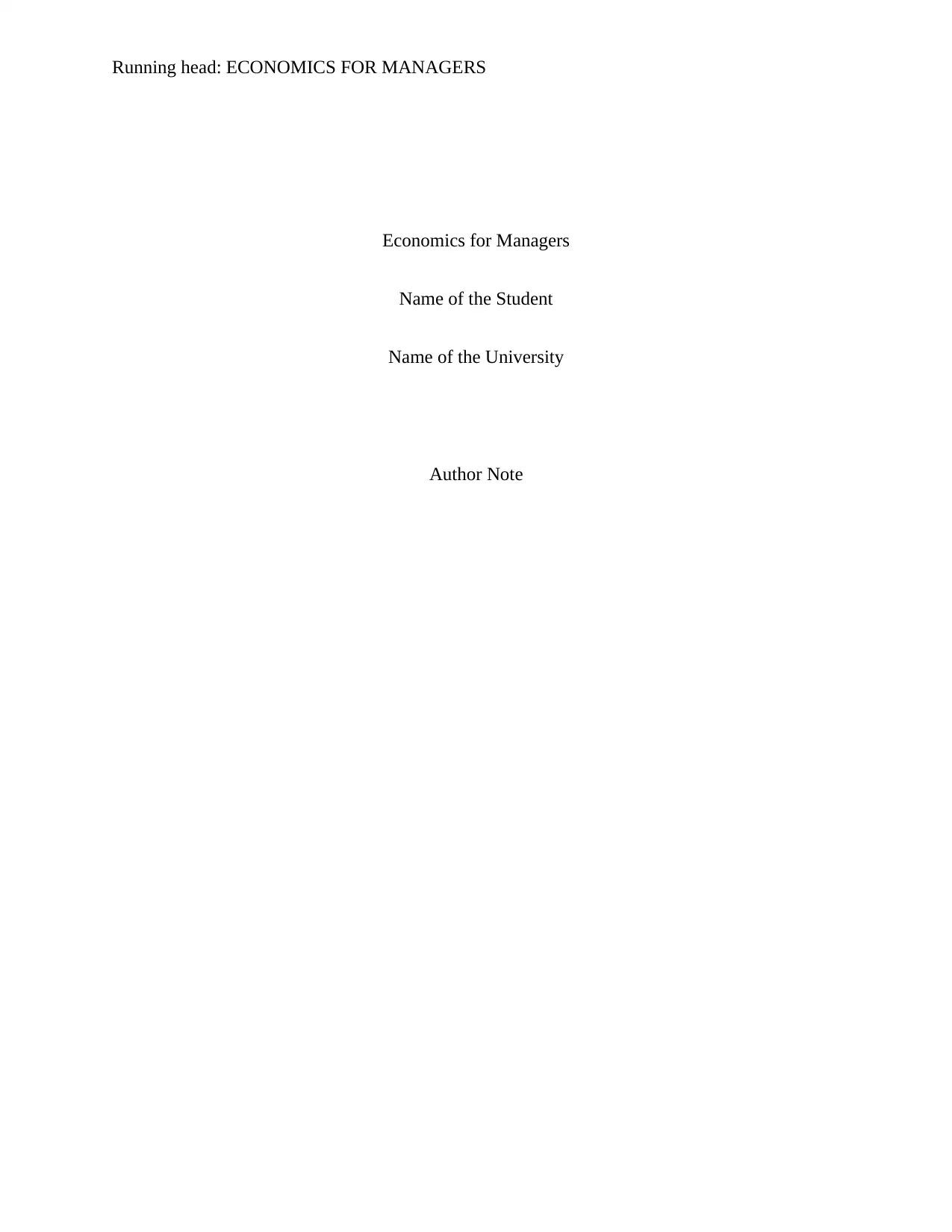
Running head: ECONOMICS FOR MANAGERS
Economics for Managers
Name of the Student
Name of the University
Author Note
Economics for Managers
Name of the Student
Name of the University
Author Note
Paraphrase This Document
Need a fresh take? Get an instant paraphrase of this document with our AI Paraphraser
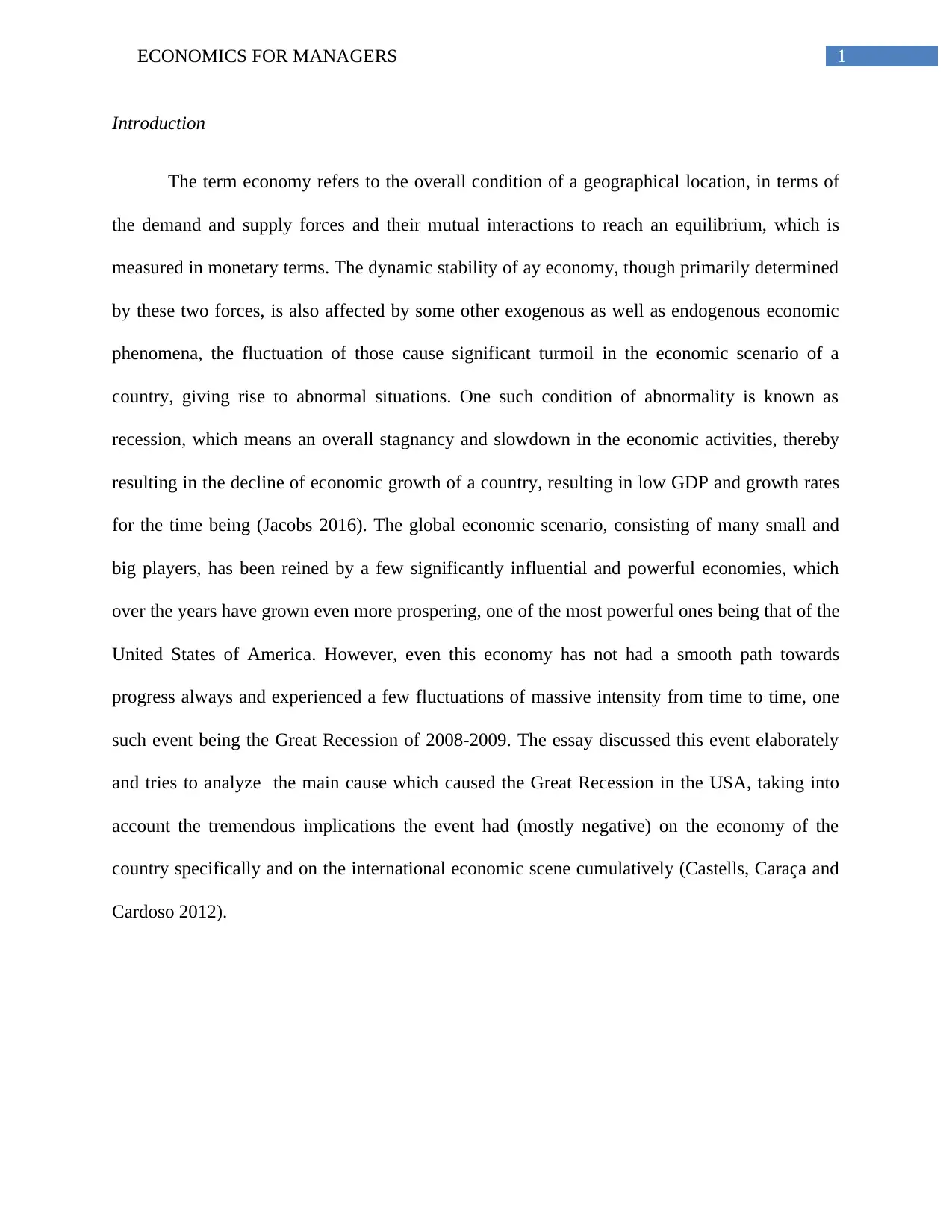
1ECONOMICS FOR MANAGERS
Introduction
The term economy refers to the overall condition of a geographical location, in terms of
the demand and supply forces and their mutual interactions to reach an equilibrium, which is
measured in monetary terms. The dynamic stability of ay economy, though primarily determined
by these two forces, is also affected by some other exogenous as well as endogenous economic
phenomena, the fluctuation of those cause significant turmoil in the economic scenario of a
country, giving rise to abnormal situations. One such condition of abnormality is known as
recession, which means an overall stagnancy and slowdown in the economic activities, thereby
resulting in the decline of economic growth of a country, resulting in low GDP and growth rates
for the time being (Jacobs 2016). The global economic scenario, consisting of many small and
big players, has been reined by a few significantly influential and powerful economies, which
over the years have grown even more prospering, one of the most powerful ones being that of the
United States of America. However, even this economy has not had a smooth path towards
progress always and experienced a few fluctuations of massive intensity from time to time, one
such event being the Great Recession of 2008-2009. The essay discussed this event elaborately
and tries to analyze the main cause which caused the Great Recession in the USA, taking into
account the tremendous implications the event had (mostly negative) on the economy of the
country specifically and on the international economic scene cumulatively (Castells, Caraça and
Cardoso 2012).
Introduction
The term economy refers to the overall condition of a geographical location, in terms of
the demand and supply forces and their mutual interactions to reach an equilibrium, which is
measured in monetary terms. The dynamic stability of ay economy, though primarily determined
by these two forces, is also affected by some other exogenous as well as endogenous economic
phenomena, the fluctuation of those cause significant turmoil in the economic scenario of a
country, giving rise to abnormal situations. One such condition of abnormality is known as
recession, which means an overall stagnancy and slowdown in the economic activities, thereby
resulting in the decline of economic growth of a country, resulting in low GDP and growth rates
for the time being (Jacobs 2016). The global economic scenario, consisting of many small and
big players, has been reined by a few significantly influential and powerful economies, which
over the years have grown even more prospering, one of the most powerful ones being that of the
United States of America. However, even this economy has not had a smooth path towards
progress always and experienced a few fluctuations of massive intensity from time to time, one
such event being the Great Recession of 2008-2009. The essay discussed this event elaborately
and tries to analyze the main cause which caused the Great Recession in the USA, taking into
account the tremendous implications the event had (mostly negative) on the economy of the
country specifically and on the international economic scene cumulatively (Castells, Caraça and
Cardoso 2012).
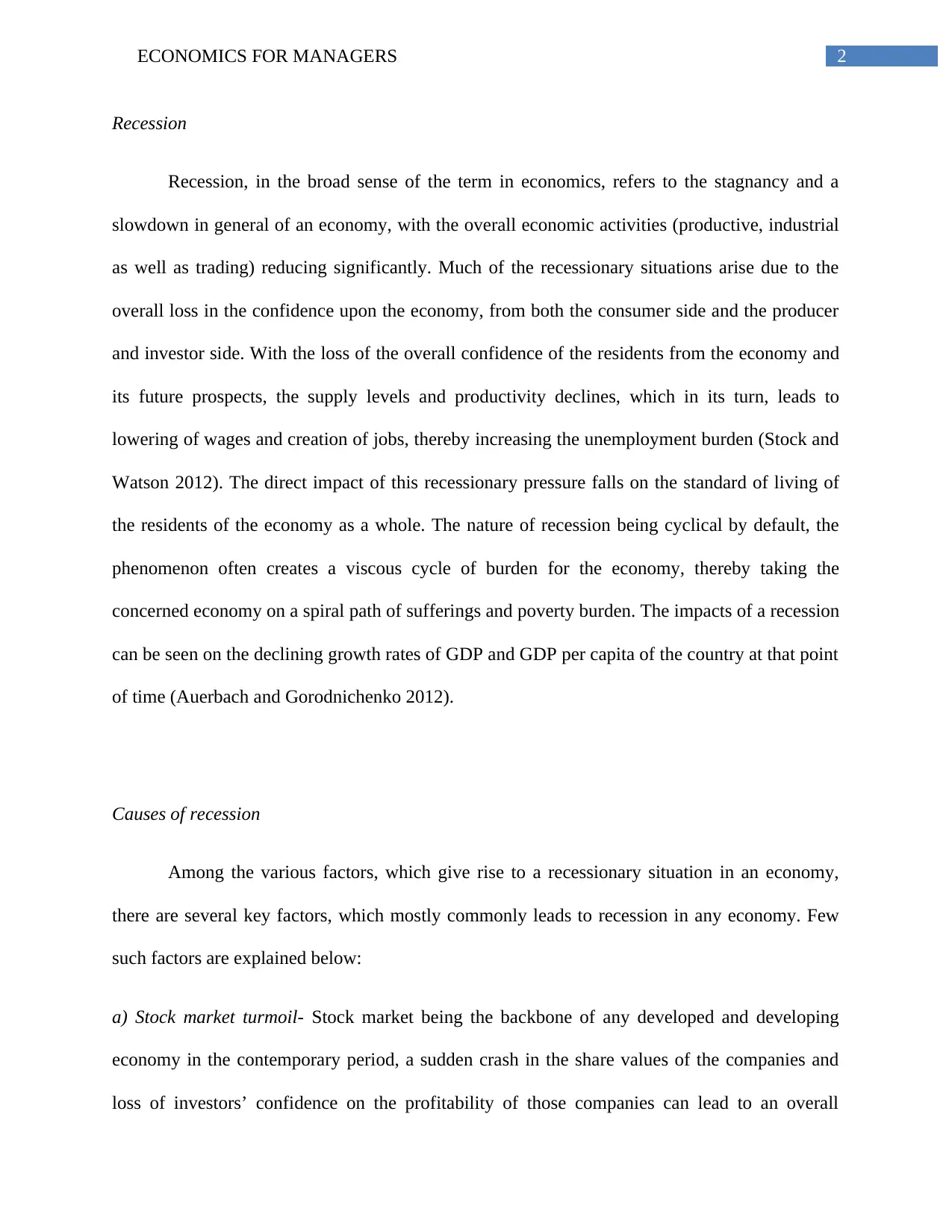
2ECONOMICS FOR MANAGERS
Recession
Recession, in the broad sense of the term in economics, refers to the stagnancy and a
slowdown in general of an economy, with the overall economic activities (productive, industrial
as well as trading) reducing significantly. Much of the recessionary situations arise due to the
overall loss in the confidence upon the economy, from both the consumer side and the producer
and investor side. With the loss of the overall confidence of the residents from the economy and
its future prospects, the supply levels and productivity declines, which in its turn, leads to
lowering of wages and creation of jobs, thereby increasing the unemployment burden (Stock and
Watson 2012). The direct impact of this recessionary pressure falls on the standard of living of
the residents of the economy as a whole. The nature of recession being cyclical by default, the
phenomenon often creates a viscous cycle of burden for the economy, thereby taking the
concerned economy on a spiral path of sufferings and poverty burden. The impacts of a recession
can be seen on the declining growth rates of GDP and GDP per capita of the country at that point
of time (Auerbach and Gorodnichenko 2012).
Causes of recession
Among the various factors, which give rise to a recessionary situation in an economy,
there are several key factors, which mostly commonly leads to recession in any economy. Few
such factors are explained below:
a) Stock market turmoil- Stock market being the backbone of any developed and developing
economy in the contemporary period, a sudden crash in the share values of the companies and
loss of investors’ confidence on the profitability of those companies can lead to an overall
Recession
Recession, in the broad sense of the term in economics, refers to the stagnancy and a
slowdown in general of an economy, with the overall economic activities (productive, industrial
as well as trading) reducing significantly. Much of the recessionary situations arise due to the
overall loss in the confidence upon the economy, from both the consumer side and the producer
and investor side. With the loss of the overall confidence of the residents from the economy and
its future prospects, the supply levels and productivity declines, which in its turn, leads to
lowering of wages and creation of jobs, thereby increasing the unemployment burden (Stock and
Watson 2012). The direct impact of this recessionary pressure falls on the standard of living of
the residents of the economy as a whole. The nature of recession being cyclical by default, the
phenomenon often creates a viscous cycle of burden for the economy, thereby taking the
concerned economy on a spiral path of sufferings and poverty burden. The impacts of a recession
can be seen on the declining growth rates of GDP and GDP per capita of the country at that point
of time (Auerbach and Gorodnichenko 2012).
Causes of recession
Among the various factors, which give rise to a recessionary situation in an economy,
there are several key factors, which mostly commonly leads to recession in any economy. Few
such factors are explained below:
a) Stock market turmoil- Stock market being the backbone of any developed and developing
economy in the contemporary period, a sudden crash in the share values of the companies and
loss of investors’ confidence on the profitability of those companies can lead to an overall
⊘ This is a preview!⊘
Do you want full access?
Subscribe today to unlock all pages.

Trusted by 1+ million students worldwide
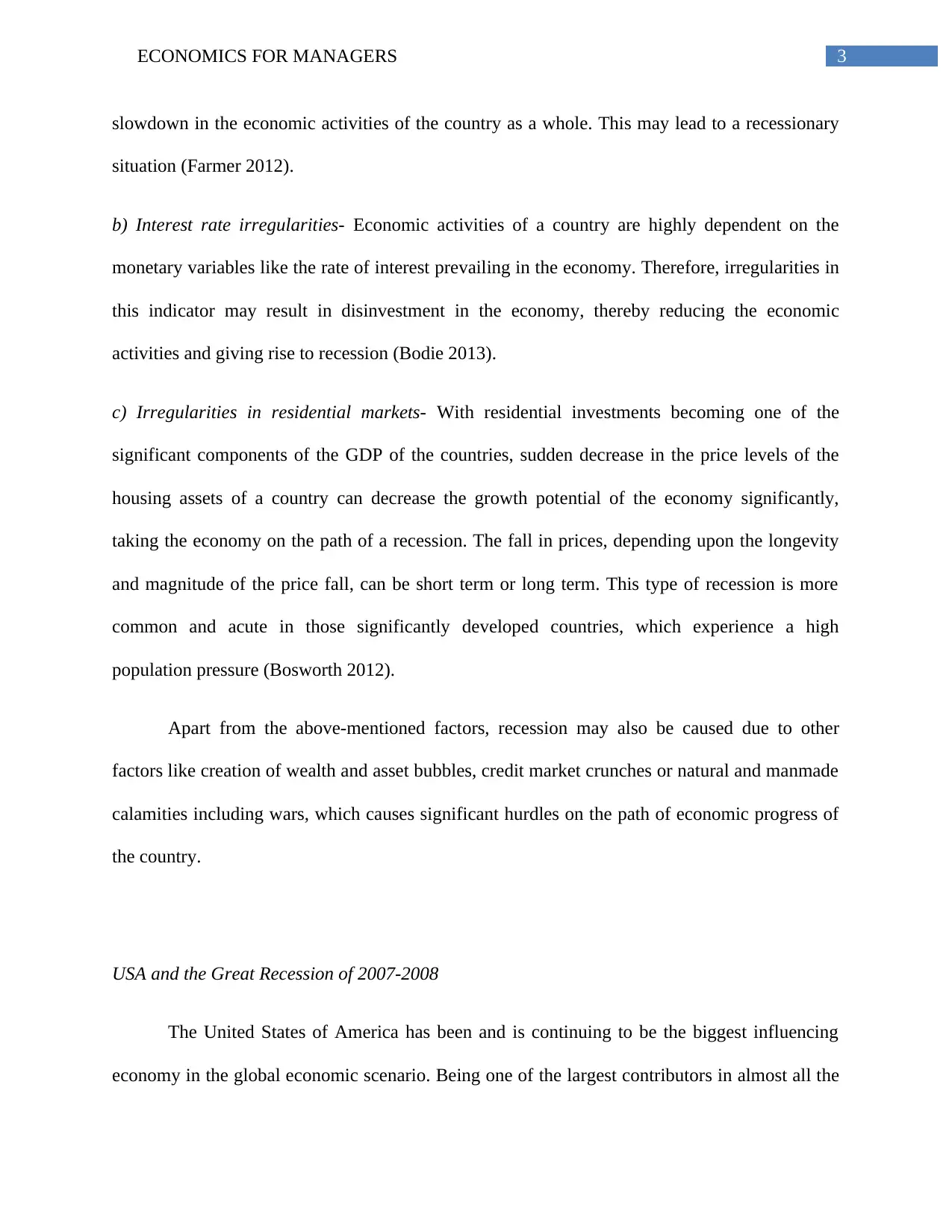
3ECONOMICS FOR MANAGERS
slowdown in the economic activities of the country as a whole. This may lead to a recessionary
situation (Farmer 2012).
b) Interest rate irregularities- Economic activities of a country are highly dependent on the
monetary variables like the rate of interest prevailing in the economy. Therefore, irregularities in
this indicator may result in disinvestment in the economy, thereby reducing the economic
activities and giving rise to recession (Bodie 2013).
c) Irregularities in residential markets- With residential investments becoming one of the
significant components of the GDP of the countries, sudden decrease in the price levels of the
housing assets of a country can decrease the growth potential of the economy significantly,
taking the economy on the path of a recession. The fall in prices, depending upon the longevity
and magnitude of the price fall, can be short term or long term. This type of recession is more
common and acute in those significantly developed countries, which experience a high
population pressure (Bosworth 2012).
Apart from the above-mentioned factors, recession may also be caused due to other
factors like creation of wealth and asset bubbles, credit market crunches or natural and manmade
calamities including wars, which causes significant hurdles on the path of economic progress of
the country.
USA and the Great Recession of 2007-2008
The United States of America has been and is continuing to be the biggest influencing
economy in the global economic scenario. Being one of the largest contributors in almost all the
slowdown in the economic activities of the country as a whole. This may lead to a recessionary
situation (Farmer 2012).
b) Interest rate irregularities- Economic activities of a country are highly dependent on the
monetary variables like the rate of interest prevailing in the economy. Therefore, irregularities in
this indicator may result in disinvestment in the economy, thereby reducing the economic
activities and giving rise to recession (Bodie 2013).
c) Irregularities in residential markets- With residential investments becoming one of the
significant components of the GDP of the countries, sudden decrease in the price levels of the
housing assets of a country can decrease the growth potential of the economy significantly,
taking the economy on the path of a recession. The fall in prices, depending upon the longevity
and magnitude of the price fall, can be short term or long term. This type of recession is more
common and acute in those significantly developed countries, which experience a high
population pressure (Bosworth 2012).
Apart from the above-mentioned factors, recession may also be caused due to other
factors like creation of wealth and asset bubbles, credit market crunches or natural and manmade
calamities including wars, which causes significant hurdles on the path of economic progress of
the country.
USA and the Great Recession of 2007-2008
The United States of America has been and is continuing to be the biggest influencing
economy in the global economic scenario. Being one of the largest contributors in almost all the
Paraphrase This Document
Need a fresh take? Get an instant paraphrase of this document with our AI Paraphraser
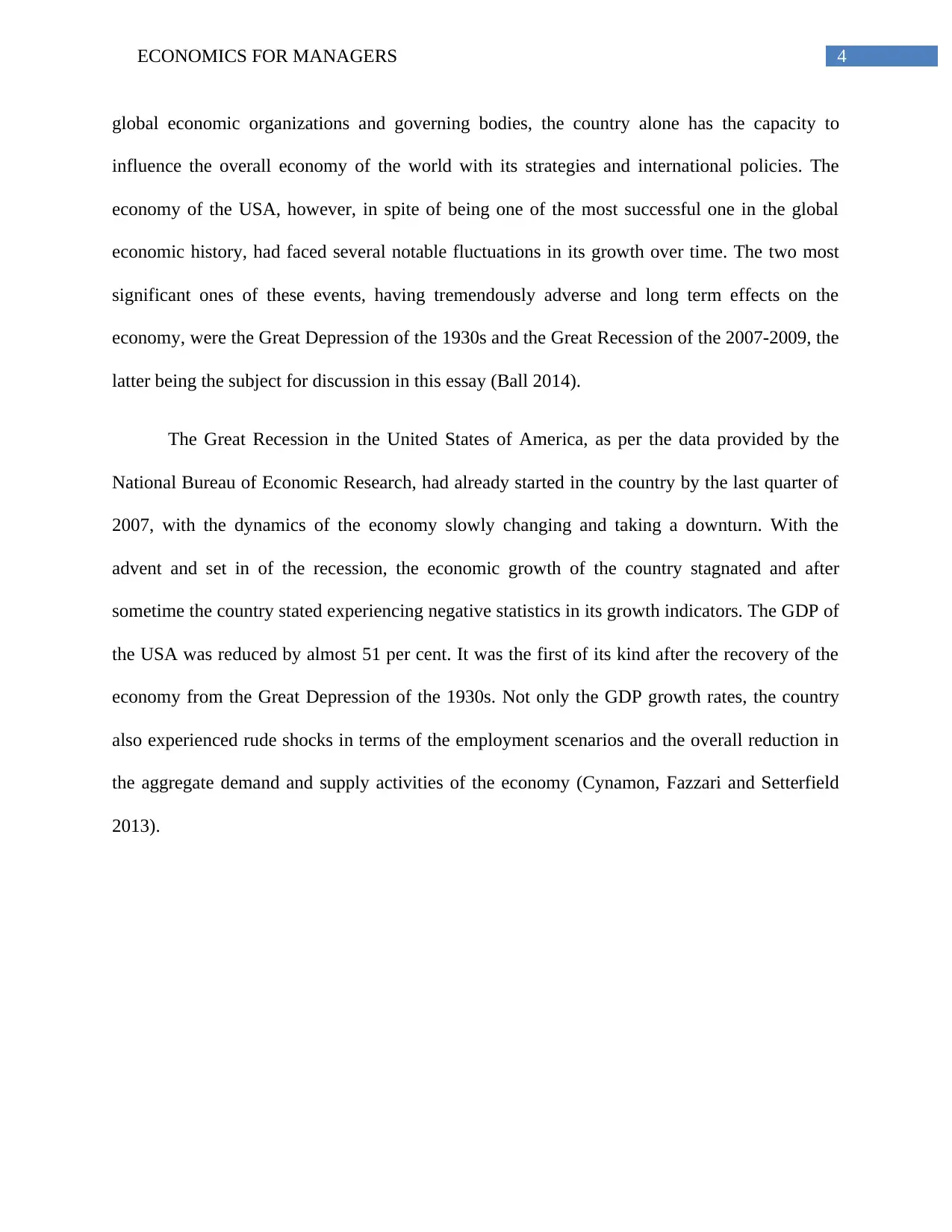
4ECONOMICS FOR MANAGERS
global economic organizations and governing bodies, the country alone has the capacity to
influence the overall economy of the world with its strategies and international policies. The
economy of the USA, however, in spite of being one of the most successful one in the global
economic history, had faced several notable fluctuations in its growth over time. The two most
significant ones of these events, having tremendously adverse and long term effects on the
economy, were the Great Depression of the 1930s and the Great Recession of the 2007-2009, the
latter being the subject for discussion in this essay (Ball 2014).
The Great Recession in the United States of America, as per the data provided by the
National Bureau of Economic Research, had already started in the country by the last quarter of
2007, with the dynamics of the economy slowly changing and taking a downturn. With the
advent and set in of the recession, the economic growth of the country stagnated and after
sometime the country stated experiencing negative statistics in its growth indicators. The GDP of
the USA was reduced by almost 51 per cent. It was the first of its kind after the recovery of the
economy from the Great Depression of the 1930s. Not only the GDP growth rates, the country
also experienced rude shocks in terms of the employment scenarios and the overall reduction in
the aggregate demand and supply activities of the economy (Cynamon, Fazzari and Setterfield
2013).
global economic organizations and governing bodies, the country alone has the capacity to
influence the overall economy of the world with its strategies and international policies. The
economy of the USA, however, in spite of being one of the most successful one in the global
economic history, had faced several notable fluctuations in its growth over time. The two most
significant ones of these events, having tremendously adverse and long term effects on the
economy, were the Great Depression of the 1930s and the Great Recession of the 2007-2009, the
latter being the subject for discussion in this essay (Ball 2014).
The Great Recession in the United States of America, as per the data provided by the
National Bureau of Economic Research, had already started in the country by the last quarter of
2007, with the dynamics of the economy slowly changing and taking a downturn. With the
advent and set in of the recession, the economic growth of the country stagnated and after
sometime the country stated experiencing negative statistics in its growth indicators. The GDP of
the USA was reduced by almost 51 per cent. It was the first of its kind after the recovery of the
economy from the Great Depression of the 1930s. Not only the GDP growth rates, the country
also experienced rude shocks in terms of the employment scenarios and the overall reduction in
the aggregate demand and supply activities of the economy (Cynamon, Fazzari and Setterfield
2013).
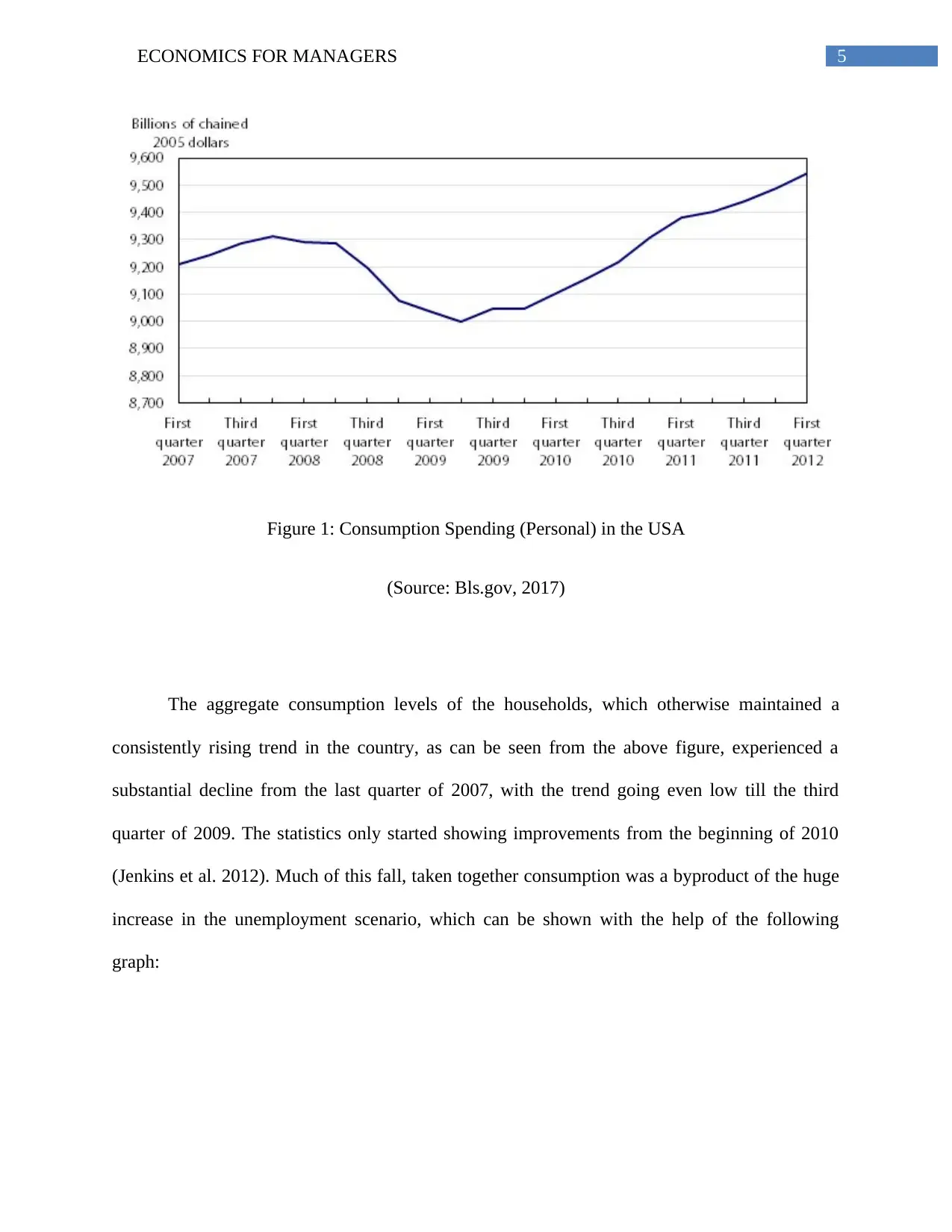
5ECONOMICS FOR MANAGERS
Figure 1: Consumption Spending (Personal) in the USA
(Source: Bls.gov, 2017)
The aggregate consumption levels of the households, which otherwise maintained a
consistently rising trend in the country, as can be seen from the above figure, experienced a
substantial decline from the last quarter of 2007, with the trend going even low till the third
quarter of 2009. The statistics only started showing improvements from the beginning of 2010
(Jenkins et al. 2012). Much of this fall, taken together consumption was a byproduct of the huge
increase in the unemployment scenario, which can be shown with the help of the following
graph:
Figure 1: Consumption Spending (Personal) in the USA
(Source: Bls.gov, 2017)
The aggregate consumption levels of the households, which otherwise maintained a
consistently rising trend in the country, as can be seen from the above figure, experienced a
substantial decline from the last quarter of 2007, with the trend going even low till the third
quarter of 2009. The statistics only started showing improvements from the beginning of 2010
(Jenkins et al. 2012). Much of this fall, taken together consumption was a byproduct of the huge
increase in the unemployment scenario, which can be shown with the help of the following
graph:
⊘ This is a preview!⊘
Do you want full access?
Subscribe today to unlock all pages.

Trusted by 1+ million students worldwide
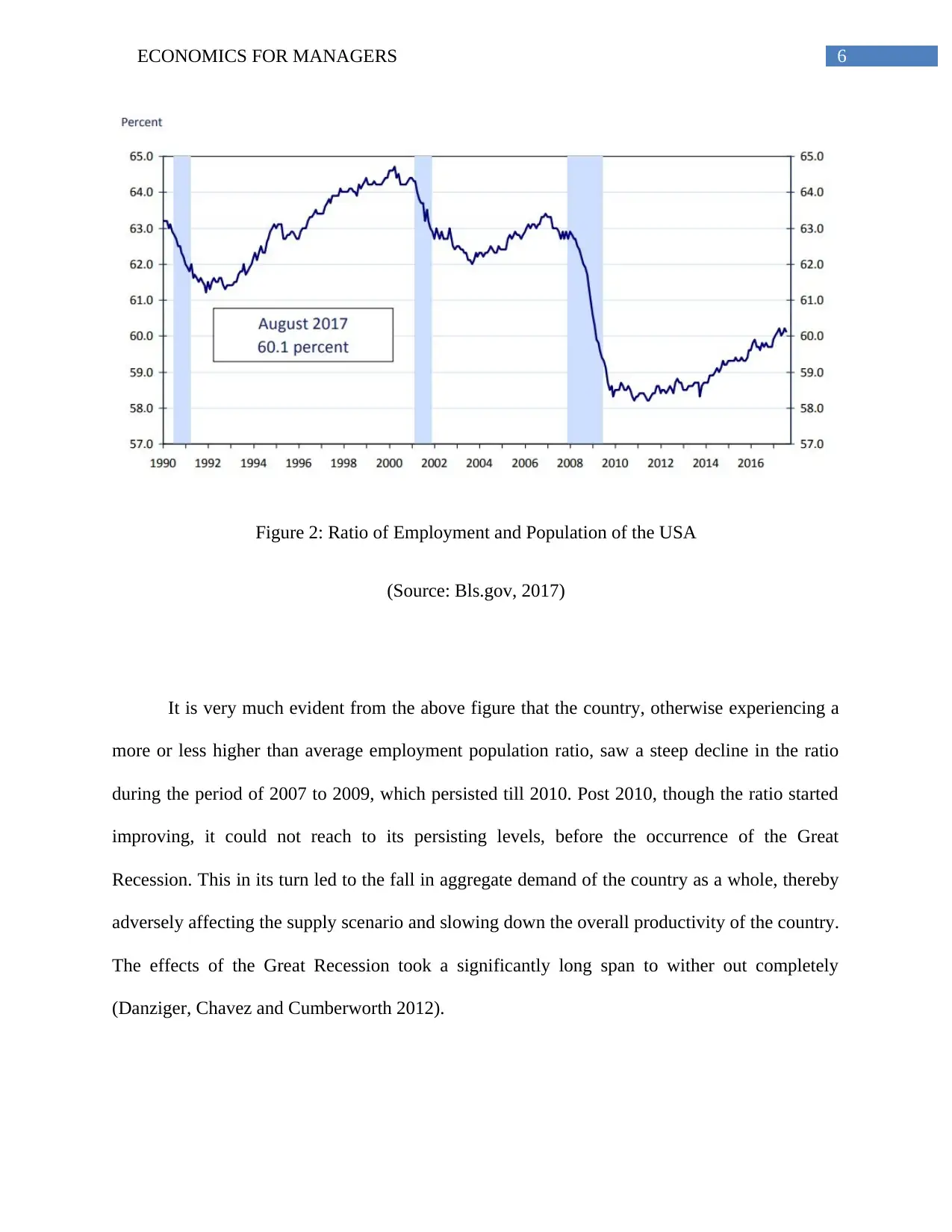
6ECONOMICS FOR MANAGERS
Figure 2: Ratio of Employment and Population of the USA
(Source: Bls.gov, 2017)
It is very much evident from the above figure that the country, otherwise experiencing a
more or less higher than average employment population ratio, saw a steep decline in the ratio
during the period of 2007 to 2009, which persisted till 2010. Post 2010, though the ratio started
improving, it could not reach to its persisting levels, before the occurrence of the Great
Recession. This in its turn led to the fall in aggregate demand of the country as a whole, thereby
adversely affecting the supply scenario and slowing down the overall productivity of the country.
The effects of the Great Recession took a significantly long span to wither out completely
(Danziger, Chavez and Cumberworth 2012).
Figure 2: Ratio of Employment and Population of the USA
(Source: Bls.gov, 2017)
It is very much evident from the above figure that the country, otherwise experiencing a
more or less higher than average employment population ratio, saw a steep decline in the ratio
during the period of 2007 to 2009, which persisted till 2010. Post 2010, though the ratio started
improving, it could not reach to its persisting levels, before the occurrence of the Great
Recession. This in its turn led to the fall in aggregate demand of the country as a whole, thereby
adversely affecting the supply scenario and slowing down the overall productivity of the country.
The effects of the Great Recession took a significantly long span to wither out completely
(Danziger, Chavez and Cumberworth 2012).
Paraphrase This Document
Need a fresh take? Get an instant paraphrase of this document with our AI Paraphraser
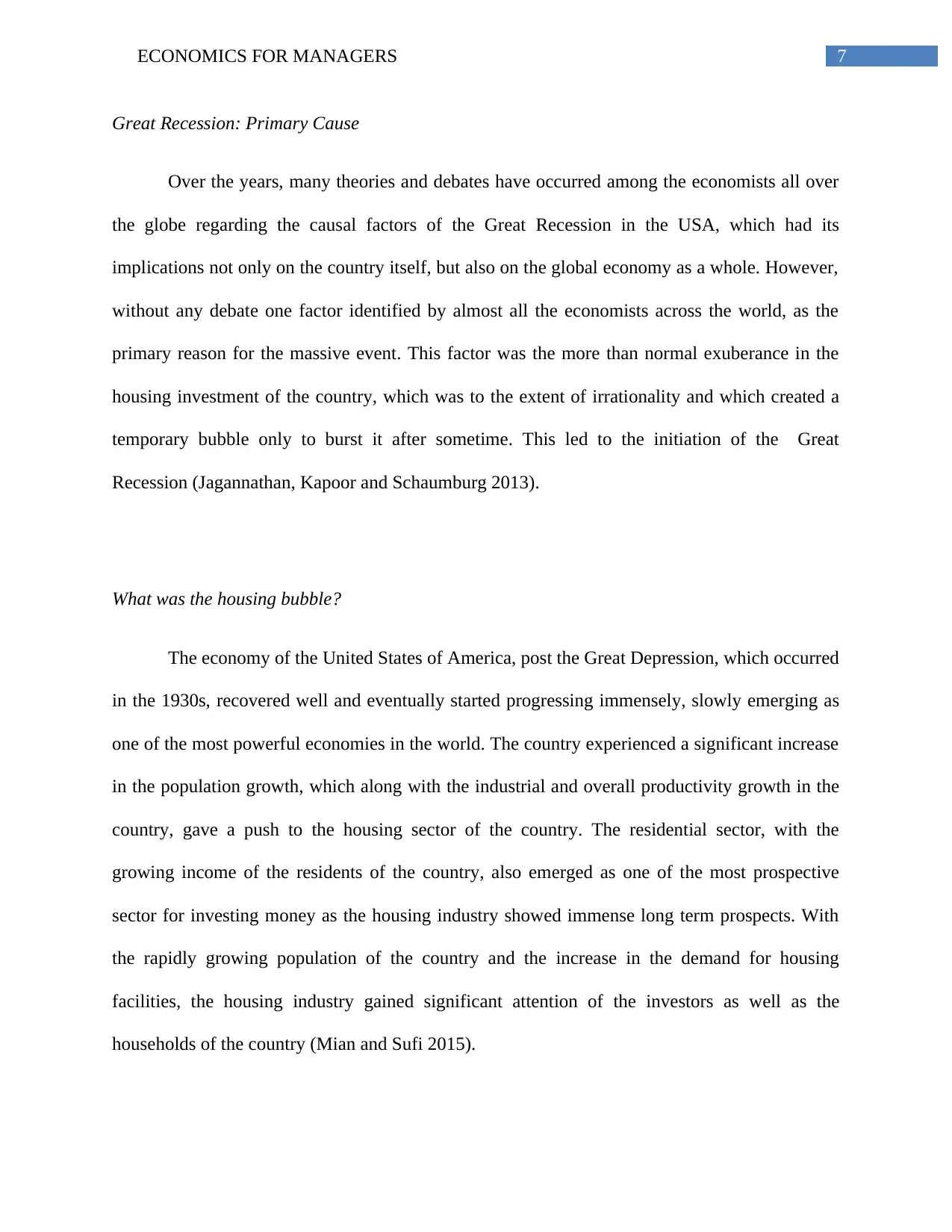
7ECONOMICS FOR MANAGERS
Great Recession: Primary Cause
Over the years, many theories and debates have occurred among the economists all over
the globe regarding the causal factors of the Great Recession in the USA, which had its
implications not only on the country itself, but also on the global economy as a whole. However,
without any debate one factor identified by almost all the economists across the world, as the
primary reason for the massive event. This factor was the more than normal exuberance in the
housing investment of the country, which was to the extent of irrationality and which created a
temporary bubble only to burst it after sometime. This led to the initiation of the Great
Recession (Jagannathan, Kapoor and Schaumburg 2013).
What was the housing bubble?
The economy of the United States of America, post the Great Depression, which occurred
in the 1930s, recovered well and eventually started progressing immensely, slowly emerging as
one of the most powerful economies in the world. The country experienced a significant increase
in the population growth, which along with the industrial and overall productivity growth in the
country, gave a push to the housing sector of the country. The residential sector, with the
growing income of the residents of the country, also emerged as one of the most prospective
sector for investing money as the housing industry showed immense long term prospects. With
the rapidly growing population of the country and the increase in the demand for housing
facilities, the housing industry gained significant attention of the investors as well as the
households of the country (Mian and Sufi 2015).
Great Recession: Primary Cause
Over the years, many theories and debates have occurred among the economists all over
the globe regarding the causal factors of the Great Recession in the USA, which had its
implications not only on the country itself, but also on the global economy as a whole. However,
without any debate one factor identified by almost all the economists across the world, as the
primary reason for the massive event. This factor was the more than normal exuberance in the
housing investment of the country, which was to the extent of irrationality and which created a
temporary bubble only to burst it after sometime. This led to the initiation of the Great
Recession (Jagannathan, Kapoor and Schaumburg 2013).
What was the housing bubble?
The economy of the United States of America, post the Great Depression, which occurred
in the 1930s, recovered well and eventually started progressing immensely, slowly emerging as
one of the most powerful economies in the world. The country experienced a significant increase
in the population growth, which along with the industrial and overall productivity growth in the
country, gave a push to the housing sector of the country. The residential sector, with the
growing income of the residents of the country, also emerged as one of the most prospective
sector for investing money as the housing industry showed immense long term prospects. With
the rapidly growing population of the country and the increase in the demand for housing
facilities, the housing industry gained significant attention of the investors as well as the
households of the country (Mian and Sufi 2015).
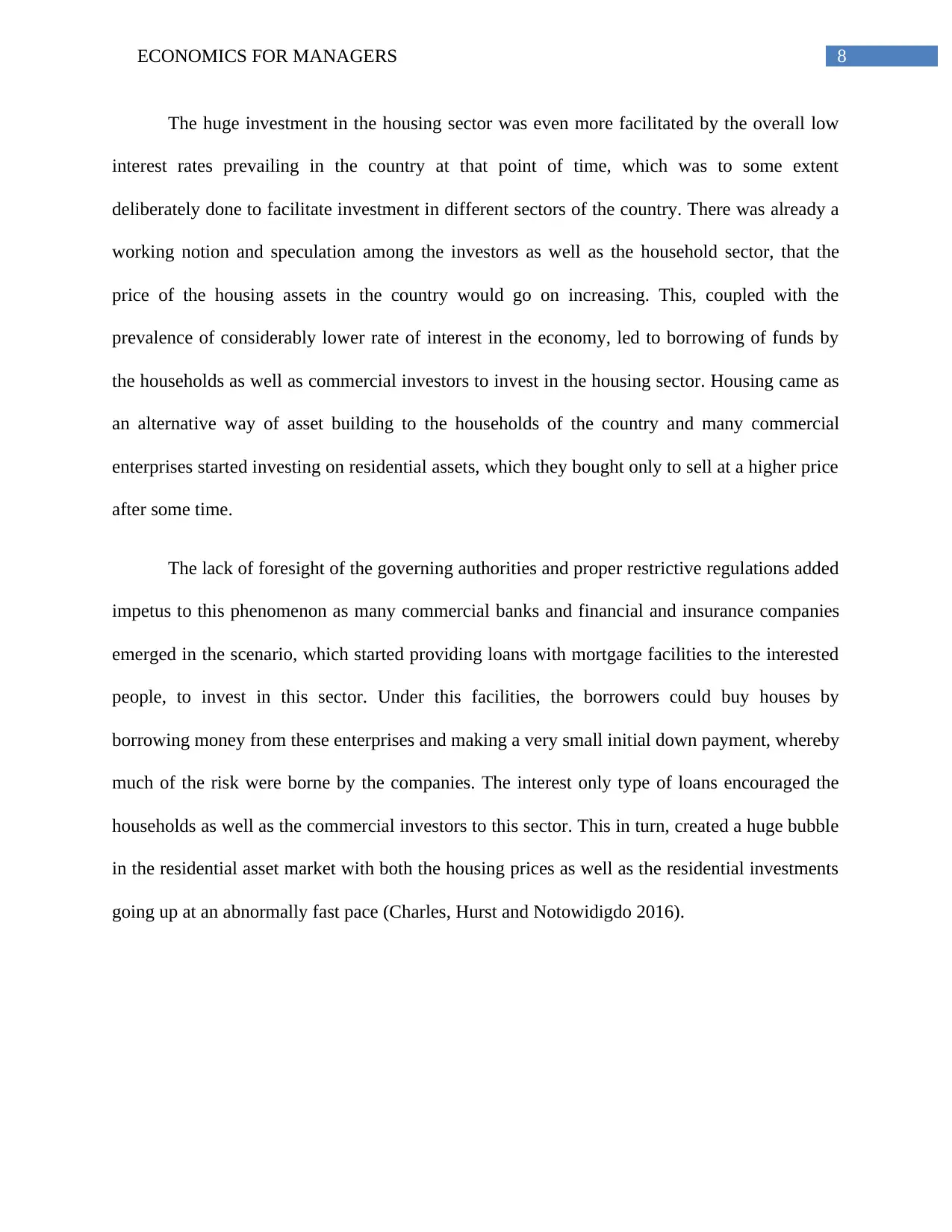
8ECONOMICS FOR MANAGERS
The huge investment in the housing sector was even more facilitated by the overall low
interest rates prevailing in the country at that point of time, which was to some extent
deliberately done to facilitate investment in different sectors of the country. There was already a
working notion and speculation among the investors as well as the household sector, that the
price of the housing assets in the country would go on increasing. This, coupled with the
prevalence of considerably lower rate of interest in the economy, led to borrowing of funds by
the households as well as commercial investors to invest in the housing sector. Housing came as
an alternative way of asset building to the households of the country and many commercial
enterprises started investing on residential assets, which they bought only to sell at a higher price
after some time.
The lack of foresight of the governing authorities and proper restrictive regulations added
impetus to this phenomenon as many commercial banks and financial and insurance companies
emerged in the scenario, which started providing loans with mortgage facilities to the interested
people, to invest in this sector. Under this facilities, the borrowers could buy houses by
borrowing money from these enterprises and making a very small initial down payment, whereby
much of the risk were borne by the companies. The interest only type of loans encouraged the
households as well as the commercial investors to this sector. This in turn, created a huge bubble
in the residential asset market with both the housing prices as well as the residential investments
going up at an abnormally fast pace (Charles, Hurst and Notowidigdo 2016).
The huge investment in the housing sector was even more facilitated by the overall low
interest rates prevailing in the country at that point of time, which was to some extent
deliberately done to facilitate investment in different sectors of the country. There was already a
working notion and speculation among the investors as well as the household sector, that the
price of the housing assets in the country would go on increasing. This, coupled with the
prevalence of considerably lower rate of interest in the economy, led to borrowing of funds by
the households as well as commercial investors to invest in the housing sector. Housing came as
an alternative way of asset building to the households of the country and many commercial
enterprises started investing on residential assets, which they bought only to sell at a higher price
after some time.
The lack of foresight of the governing authorities and proper restrictive regulations added
impetus to this phenomenon as many commercial banks and financial and insurance companies
emerged in the scenario, which started providing loans with mortgage facilities to the interested
people, to invest in this sector. Under this facilities, the borrowers could buy houses by
borrowing money from these enterprises and making a very small initial down payment, whereby
much of the risk were borne by the companies. The interest only type of loans encouraged the
households as well as the commercial investors to this sector. This in turn, created a huge bubble
in the residential asset market with both the housing prices as well as the residential investments
going up at an abnormally fast pace (Charles, Hurst and Notowidigdo 2016).
⊘ This is a preview!⊘
Do you want full access?
Subscribe today to unlock all pages.

Trusted by 1+ million students worldwide
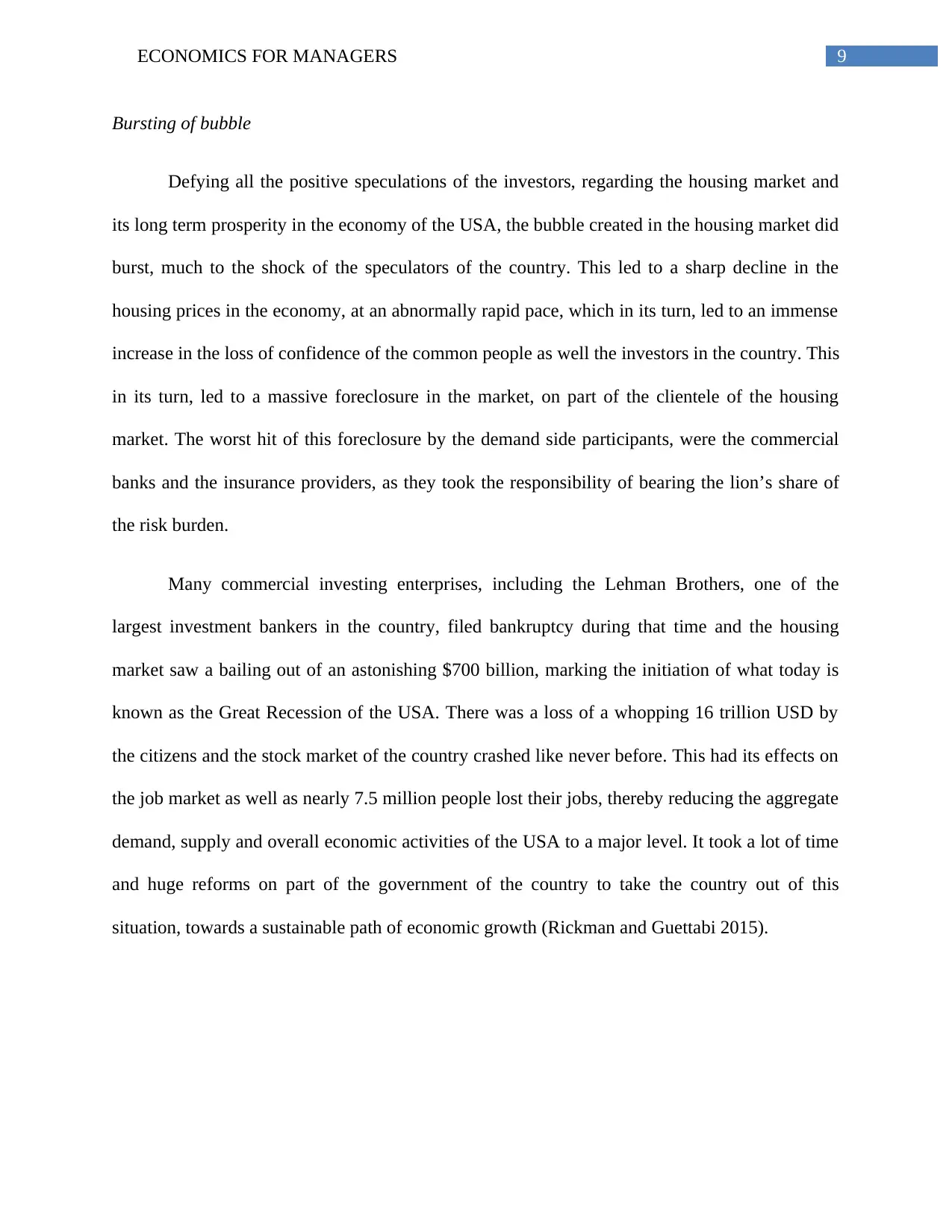
9ECONOMICS FOR MANAGERS
Bursting of bubble
Defying all the positive speculations of the investors, regarding the housing market and
its long term prosperity in the economy of the USA, the bubble created in the housing market did
burst, much to the shock of the speculators of the country. This led to a sharp decline in the
housing prices in the economy, at an abnormally rapid pace, which in its turn, led to an immense
increase in the loss of confidence of the common people as well the investors in the country. This
in its turn, led to a massive foreclosure in the market, on part of the clientele of the housing
market. The worst hit of this foreclosure by the demand side participants, were the commercial
banks and the insurance providers, as they took the responsibility of bearing the lion’s share of
the risk burden.
Many commercial investing enterprises, including the Lehman Brothers, one of the
largest investment bankers in the country, filed bankruptcy during that time and the housing
market saw a bailing out of an astonishing $700 billion, marking the initiation of what today is
known as the Great Recession of the USA. There was a loss of a whopping 16 trillion USD by
the citizens and the stock market of the country crashed like never before. This had its effects on
the job market as well as nearly 7.5 million people lost their jobs, thereby reducing the aggregate
demand, supply and overall economic activities of the USA to a major level. It took a lot of time
and huge reforms on part of the government of the country to take the country out of this
situation, towards a sustainable path of economic growth (Rickman and Guettabi 2015).
Bursting of bubble
Defying all the positive speculations of the investors, regarding the housing market and
its long term prosperity in the economy of the USA, the bubble created in the housing market did
burst, much to the shock of the speculators of the country. This led to a sharp decline in the
housing prices in the economy, at an abnormally rapid pace, which in its turn, led to an immense
increase in the loss of confidence of the common people as well the investors in the country. This
in its turn, led to a massive foreclosure in the market, on part of the clientele of the housing
market. The worst hit of this foreclosure by the demand side participants, were the commercial
banks and the insurance providers, as they took the responsibility of bearing the lion’s share of
the risk burden.
Many commercial investing enterprises, including the Lehman Brothers, one of the
largest investment bankers in the country, filed bankruptcy during that time and the housing
market saw a bailing out of an astonishing $700 billion, marking the initiation of what today is
known as the Great Recession of the USA. There was a loss of a whopping 16 trillion USD by
the citizens and the stock market of the country crashed like never before. This had its effects on
the job market as well as nearly 7.5 million people lost their jobs, thereby reducing the aggregate
demand, supply and overall economic activities of the USA to a major level. It took a lot of time
and huge reforms on part of the government of the country to take the country out of this
situation, towards a sustainable path of economic growth (Rickman and Guettabi 2015).
Paraphrase This Document
Need a fresh take? Get an instant paraphrase of this document with our AI Paraphraser
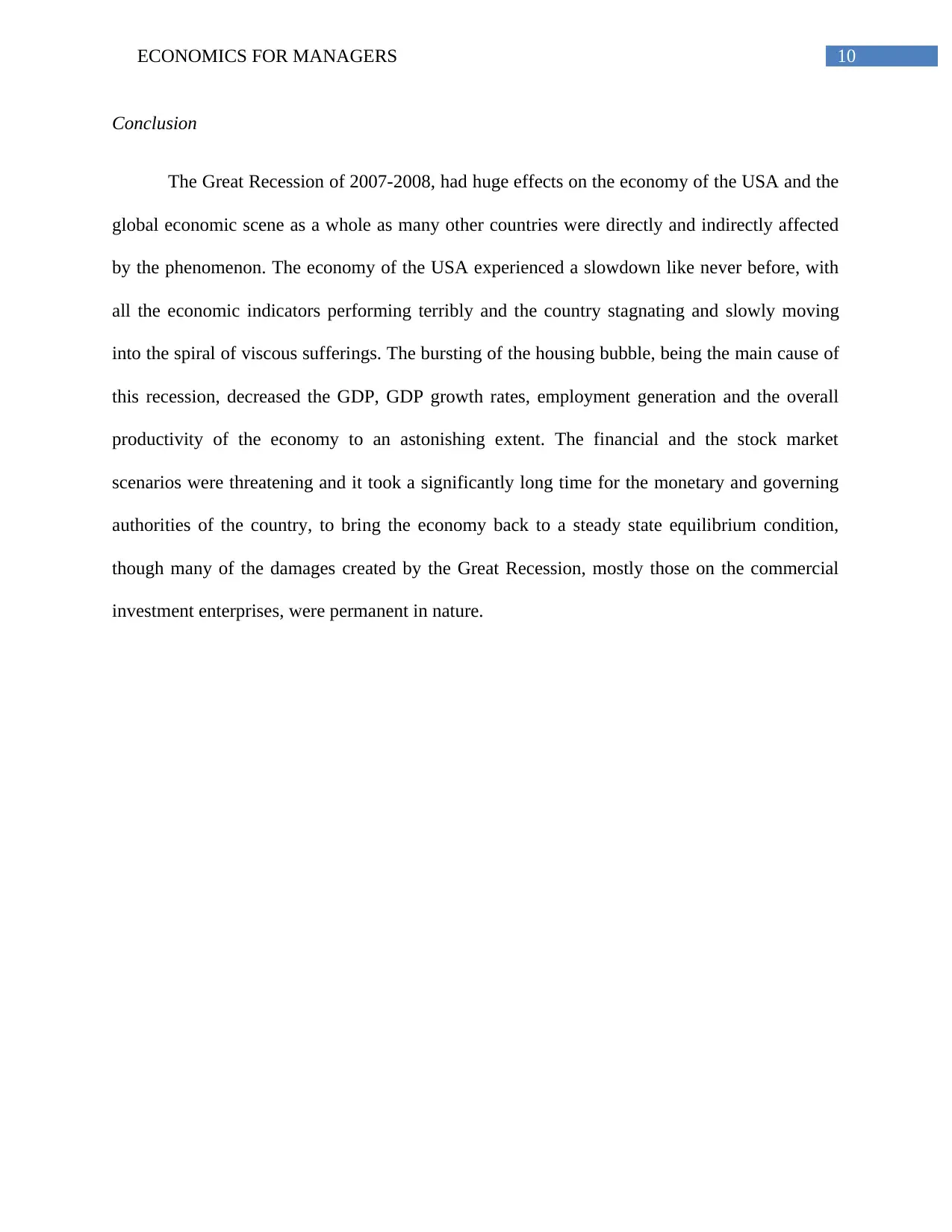
10ECONOMICS FOR MANAGERS
Conclusion
The Great Recession of 2007-2008, had huge effects on the economy of the USA and the
global economic scene as a whole as many other countries were directly and indirectly affected
by the phenomenon. The economy of the USA experienced a slowdown like never before, with
all the economic indicators performing terribly and the country stagnating and slowly moving
into the spiral of viscous sufferings. The bursting of the housing bubble, being the main cause of
this recession, decreased the GDP, GDP growth rates, employment generation and the overall
productivity of the economy to an astonishing extent. The financial and the stock market
scenarios were threatening and it took a significantly long time for the monetary and governing
authorities of the country, to bring the economy back to a steady state equilibrium condition,
though many of the damages created by the Great Recession, mostly those on the commercial
investment enterprises, were permanent in nature.
Conclusion
The Great Recession of 2007-2008, had huge effects on the economy of the USA and the
global economic scene as a whole as many other countries were directly and indirectly affected
by the phenomenon. The economy of the USA experienced a slowdown like never before, with
all the economic indicators performing terribly and the country stagnating and slowly moving
into the spiral of viscous sufferings. The bursting of the housing bubble, being the main cause of
this recession, decreased the GDP, GDP growth rates, employment generation and the overall
productivity of the economy to an astonishing extent. The financial and the stock market
scenarios were threatening and it took a significantly long time for the monetary and governing
authorities of the country, to bring the economy back to a steady state equilibrium condition,
though many of the damages created by the Great Recession, mostly those on the commercial
investment enterprises, were permanent in nature.
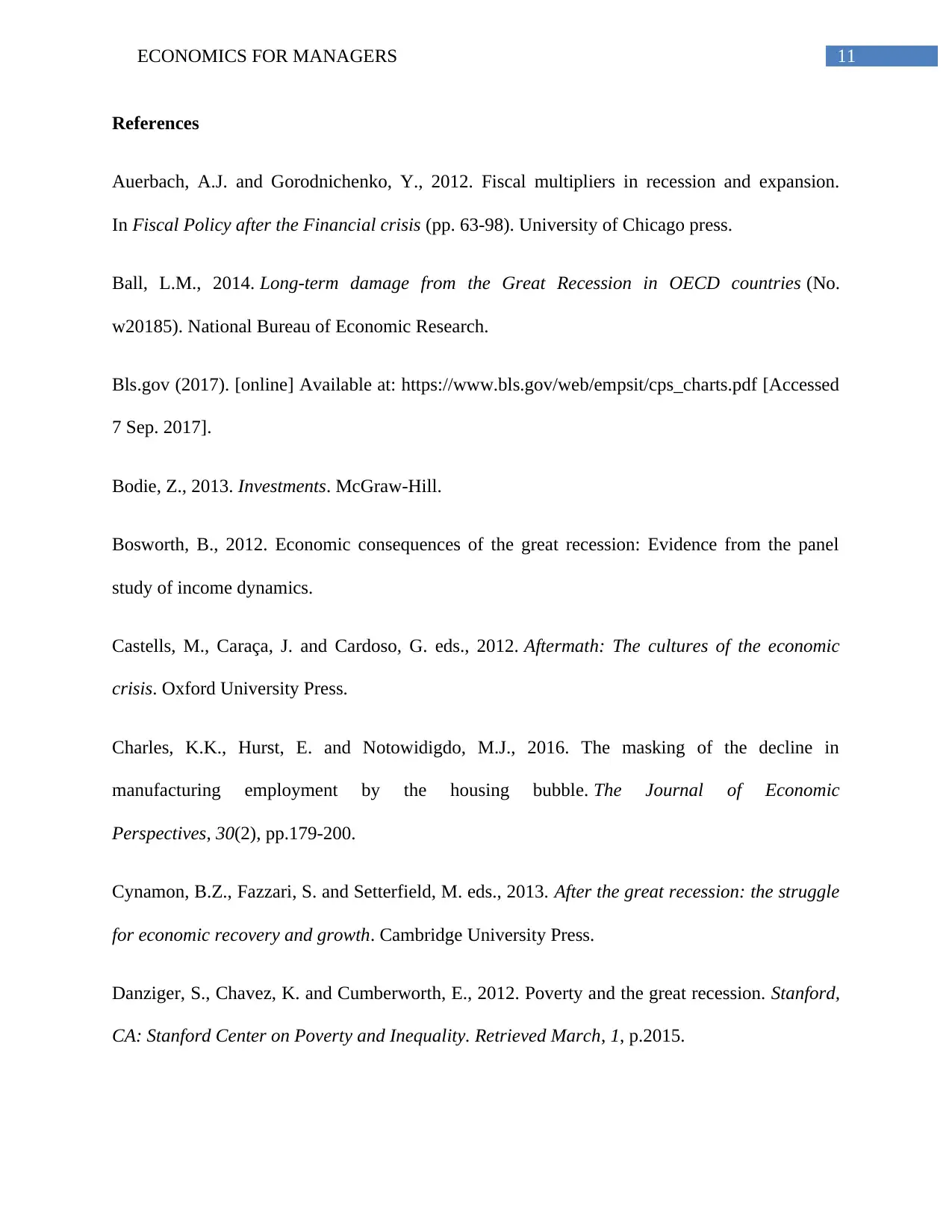
11ECONOMICS FOR MANAGERS
References
Auerbach, A.J. and Gorodnichenko, Y., 2012. Fiscal multipliers in recession and expansion.
In Fiscal Policy after the Financial crisis (pp. 63-98). University of Chicago press.
Ball, L.M., 2014. Long-term damage from the Great Recession in OECD countries (No.
w20185). National Bureau of Economic Research.
Bls.gov (2017). [online] Available at: https://www.bls.gov/web/empsit/cps_charts.pdf [Accessed
7 Sep. 2017].
Bodie, Z., 2013. Investments. McGraw-Hill.
Bosworth, B., 2012. Economic consequences of the great recession: Evidence from the panel
study of income dynamics.
Castells, M., Caraça, J. and Cardoso, G. eds., 2012. Aftermath: The cultures of the economic
crisis. Oxford University Press.
Charles, K.K., Hurst, E. and Notowidigdo, M.J., 2016. The masking of the decline in
manufacturing employment by the housing bubble. The Journal of Economic
Perspectives, 30(2), pp.179-200.
Cynamon, B.Z., Fazzari, S. and Setterfield, M. eds., 2013. After the great recession: the struggle
for economic recovery and growth. Cambridge University Press.
Danziger, S., Chavez, K. and Cumberworth, E., 2012. Poverty and the great recession. Stanford,
CA: Stanford Center on Poverty and Inequality. Retrieved March, 1, p.2015.
References
Auerbach, A.J. and Gorodnichenko, Y., 2012. Fiscal multipliers in recession and expansion.
In Fiscal Policy after the Financial crisis (pp. 63-98). University of Chicago press.
Ball, L.M., 2014. Long-term damage from the Great Recession in OECD countries (No.
w20185). National Bureau of Economic Research.
Bls.gov (2017). [online] Available at: https://www.bls.gov/web/empsit/cps_charts.pdf [Accessed
7 Sep. 2017].
Bodie, Z., 2013. Investments. McGraw-Hill.
Bosworth, B., 2012. Economic consequences of the great recession: Evidence from the panel
study of income dynamics.
Castells, M., Caraça, J. and Cardoso, G. eds., 2012. Aftermath: The cultures of the economic
crisis. Oxford University Press.
Charles, K.K., Hurst, E. and Notowidigdo, M.J., 2016. The masking of the decline in
manufacturing employment by the housing bubble. The Journal of Economic
Perspectives, 30(2), pp.179-200.
Cynamon, B.Z., Fazzari, S. and Setterfield, M. eds., 2013. After the great recession: the struggle
for economic recovery and growth. Cambridge University Press.
Danziger, S., Chavez, K. and Cumberworth, E., 2012. Poverty and the great recession. Stanford,
CA: Stanford Center on Poverty and Inequality. Retrieved March, 1, p.2015.
⊘ This is a preview!⊘
Do you want full access?
Subscribe today to unlock all pages.

Trusted by 1+ million students worldwide
1 out of 13
Related Documents
Your All-in-One AI-Powered Toolkit for Academic Success.
+13062052269
info@desklib.com
Available 24*7 on WhatsApp / Email
![[object Object]](/_next/static/media/star-bottom.7253800d.svg)
Unlock your academic potential
Copyright © 2020–2025 A2Z Services. All Rights Reserved. Developed and managed by ZUCOL.




